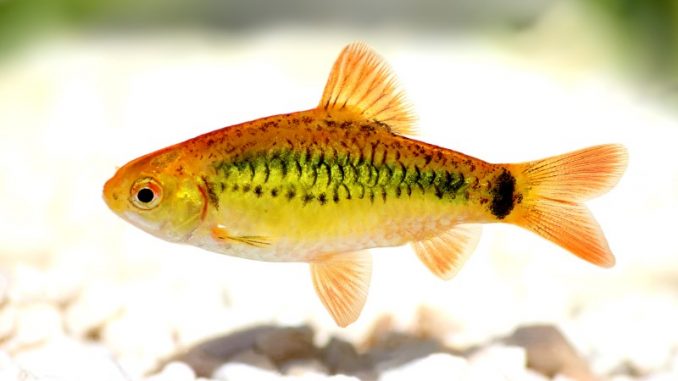
Barbs are ray-finned fish that are usually peaceful. There are over 20 types of barbs, and most species are found in Asia and Africa.
The barb species is easy to care for and common in the pet trade.
TABLE OF CONTENTS
- Chubbyhead Barb
- Clown Barb
- Denison Barb
- Gold Barb
- Beardless Barb
- Five Banded Barb
- Green Stripe Barb
- Khavli Barb / Maharaja Barb
- Sawbwa Barb
- Tiger Barb
- Tinfoil Barb
- Ticto Barb / Odessa Barb / Red Crystal Barb
- Swamp Barb
- Spanner Barb
- Rosy Barb
- Redside Barb / Two-Spot Barb
- Checker Barb
- Cherry Barb
- Arulius Barb
- Choosing & Caring For Different Types of Barb Fish
Chubbyhead Barb
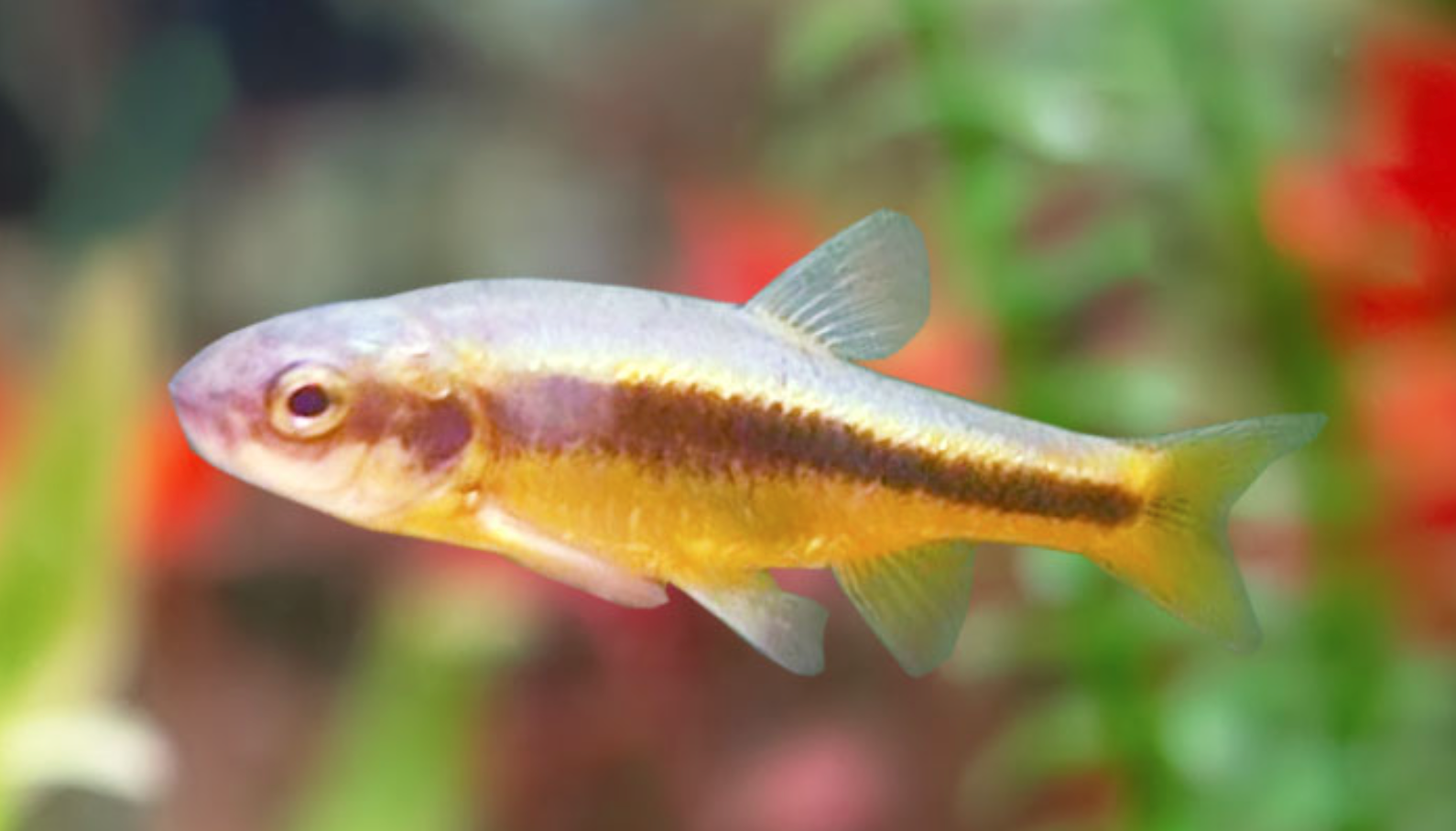
| Care level: | Temperament: | Color: | Lifespan: | Size: |
| Easy | Semi-aggressive | Gold, silver, to and black | Up to 3 years | 5 inches |
| Water temperature: | Water pH: | Tank size: | Diet: | Scientific name: |
| 60–71 °F | 6.8–7.8 | 25 gallons | Omnivore | Enteromius anoplus, formerly Barbus anoplus |
The chubbyhead barb is a schooling freshwater fish that does well in clear and brackish water. Chubbyhead barbs are gold or silver with black markings, blunt heads, and small mouths.
You should decorate the chubbyhead barb’s tank with natural plants and plenty of hiding spaces to replicate the fish’s natural habitat.
Feed the chubbyhead barb a mixed, omnivorous diet consisting of fish food flakes and live or frozen brine shrimp and mosquito larvae.
Clown Barb
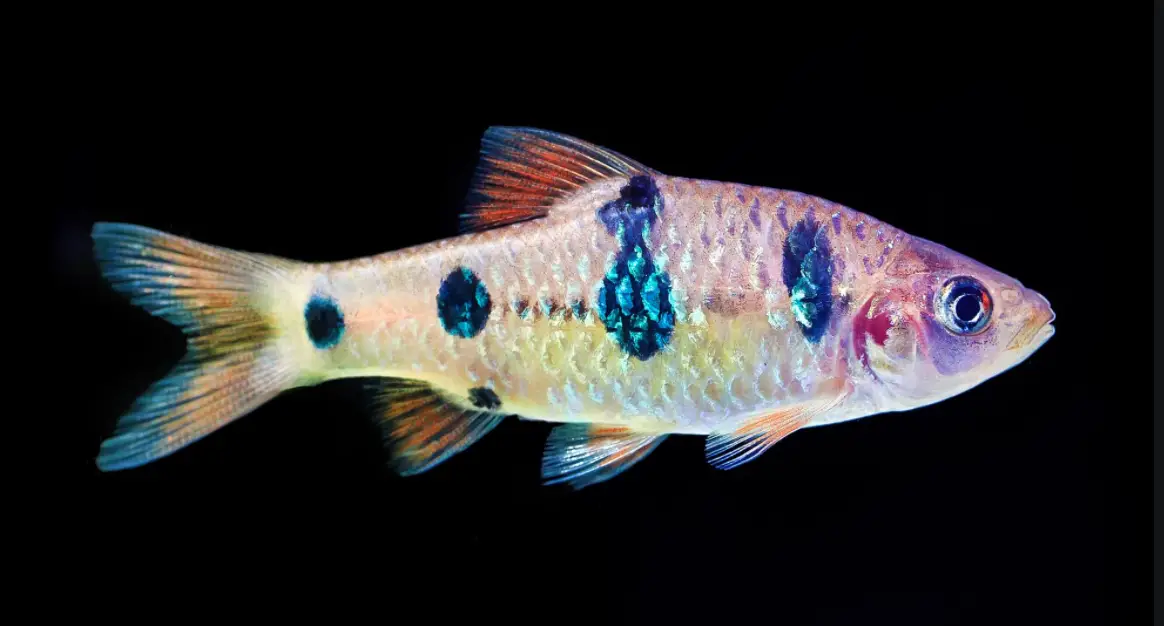
| Care level: | Temperament: | Color: | Lifespan: | Size: |
| Moderate | Semi-aggressive | Red and gold | 4–8 years | 6 inches |
| Water temperature: | Water pH: | Tank size: | Diet: | Scientific name: |
| 79–82 °F | 6.0–8.0 | 25–30 gallons | Omnivore | Barbodes everetti |
Clown barbs are an interesting-looking species of barb, with red fins, orange bodies, and black bands on their sides. Unlike their barb relatives, clown barbs are semi-aggressive and can be difficult to care for.
Wild clown barbs will grow up to 6 inches long, and captive clown barbs rarely grow larger than 4 inches long.
Clown barbs should be housed in schools of at least six similarly-sized fish.
Feed clown barbs a mixed diet of fish flakes, sinking pellets, live or frozen foods, and vegetables like spinach and lettuce.
Denison Barb
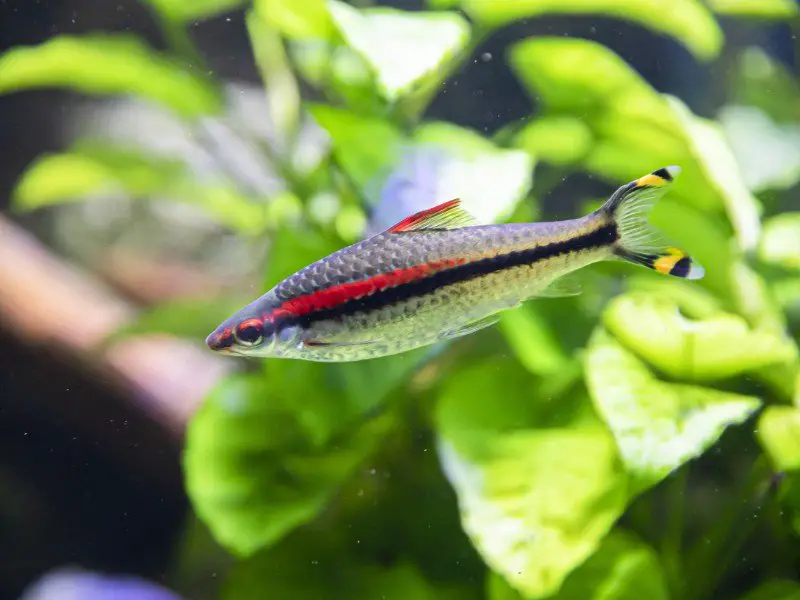
| Care level: | Temperament: | Color: | Lifespan: | Size: |
| Advanced | Semi-aggressive | Patches or stripes of bright green, red, and black | Up to 5 years | 6 inches |
| Water temperature: | Water pH: | Tank size: | Diet: | Scientific name: |
| 60–77 °F | 6.8–8.8 | 55 gallons | Omnivore | Sahyadria denisonii |
Denison barbs have stripes of green and red that run down their slender bodies. The fish are a large species of barb that require a large tank to thrive.
The denison barb is on the IUCN red list and classified as “endangered.” This is caused by overfishing and damage to the fish’s natural habitat.
Breeding denison barbs in captivity is difficult. Even experienced fish farmers struggle to breed denison barbs, making the fish rare in captivity and hard to find online and in pet stores.
Gold Barb

| Care level: | Temperament: | Color: | Lifespan: | Size: |
| Easy | Peaceful | Gold and black | 6 years | 3 inches |
| Water temperature: | Water pH: | Tank size: | Diet: | Scientific name: |
| 64–75 °F | 6.0–8.0 | 20 gallons | Omnivore | Barbodes semifasciolatus |
These fish are naturally green in the wild, but gold barbs sold in pet stores have gold bodies with small black patches and reddish, see-through fins.
Gold barbs are easy to care for and are a good choice for beginner fishkeepers. These peaceful fish are suitable for community tanks because they get along well with other easy-going freshwater fish.
Native to Asia, gold barbs can be found in shallow water in rivers and slow-flowing streams. These fish gather in schools of six or more in the wild, and you should keep at least six gold barbs together in captivity.
Beardless Barb
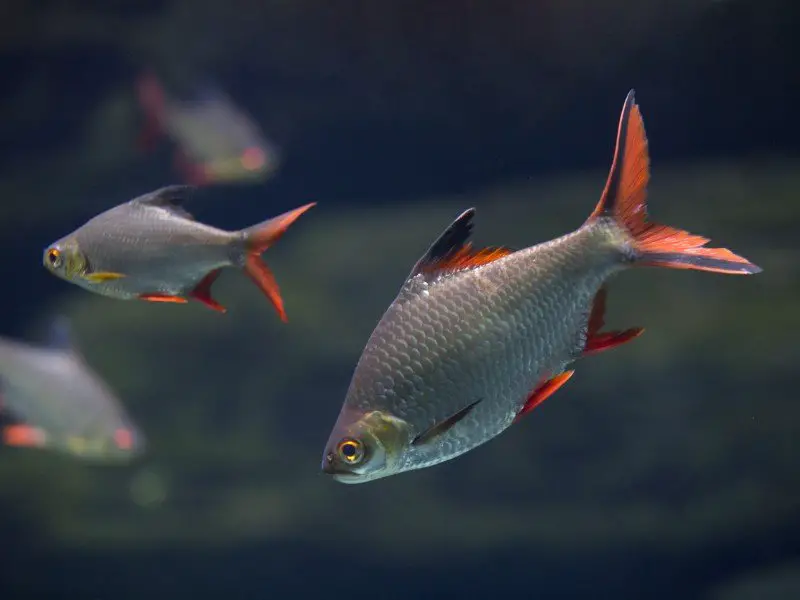
| Care level: | Temperament: | Color: | Lifespan: | Size: |
| Moderate | Peaceful | Silver/gray | Undetermined, around 4–6 years | 7 inches |
| Water temperature: | Water pH: | Tank size: | Diet: | Scientific name: |
| 68–78 °F | 5.5–8.0 | 30 gallons | Omnivore | Cyclocheilichthys apogon |
Beardless barbs are iridescent silver fish that don’t have a barbel (a sensory organ near the mouth that looks like a whisker). Most beardless barbs are found in mainland Southeast Asia and inhabit tropical freshwater environments.
These fish eat small insects, crustaceans, and fry. You should keep beardless barbs away from non-fish tankmates and juvenile fish so they won’t be eaten by the beardless barbs.
Despite their large appetite, beardless barbs are peaceful fish and as long as they are fed well, they won’t fight to compete for food.
Five Banded Barb

| Care level: | Temperament: | Color: | Lifespan: | Size: |
| Easy | Peaceful | Red, orange, and gold | 3 years | 2 inches |
| Water temperature: | Water pH: | Tank size: | Diet: | Scientific name: |
| 77–82 °F | 4.0–7.0 | 20 gallons | Omnivore | Desmopuntius pentazona |
The five banded barb has five black vertical stripes on its body, making it easy to spot in a community tank. You should keep five banded barbs in schools of six or more.
In the wild, five banded barbs are found in heavily vegetated streams, ponds, and ditches, and you should replicate this habitat in a planted freshwater tank with a slow-moving current. Using a dark substrate and decor will bring out this fish’s beautiful red, orange, and gold coloration.
Breeding five banded barbs is difficult in captivity. Inducing spawning behavior in this species in captivity is challenging, and few aquarists succeed.
Green Stripe Barb

| Care level: | Temperament: | Color: | Lifespan: | Size: |
| Easy | Peaceful | Orange, gold, and black | Up to 6 years | 2 inches |
| Water temperature: | Water pH: | Tank size: | Diet: | Scientific name: |
| 65–79 °F | 6.0–7.5 | 20 gallons | Omnivore | Puntius vittatus |
The green stripe barb – also called greenstripe barb, silver barb, or striped barb – is a hardy fish that can live in tropical and brackish water. The green stripe barb is tolerant to a wide range of water temperatures and varying optimal acidity, making the fish ideal for community tanks.
Decorate the green stripe barb’s tank with dark substrate and lots of plants.
To maintain the bright colors of the green stripe barb, feed the fish regular meals of small, live, or frozen foods like brine shrimp and bloodworms.
Green stripe barbs are peaceful fish that make suitable tank mates for most other fish species. Buy green stripe barbs in groups of at least eight to ensure the fish feel safe in the tank.
Khavli Barb / Maharaja Barb
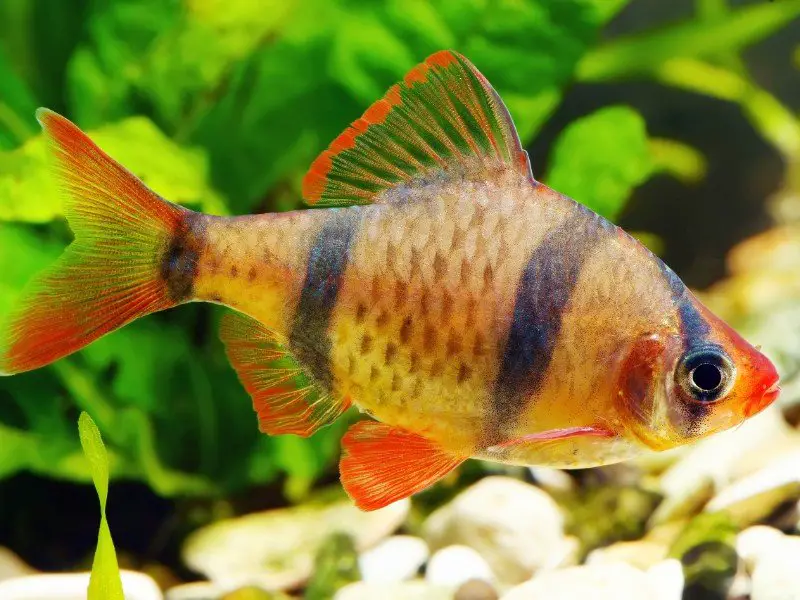
| Care level: | Temperament: | Color: | Lifespan: | Size: |
| Easy | Peaceful | Gold and black | Undetermined, around 4–6 years | 2.5 inches |
| Water temperature: | Water pH: | Tank size: | Diet: | Scientific name: |
| 68–79 °F | 6.8–7.8 | 25 gallons | Omnivore | Puntius sahyadriensis |
The khavli barb, or the maharaja barb, is a small fish found in fast-flowing hill streams in India. Khavli barbs are peaceful fish that are rarely nippy, making them suitable for most community tanks. House khavli barbs in a planted aquarium in a group of at least six.
Other barb species are occasionally mis-sold as khavli barbs. A true khavli barb is identifiable by its gold body and black spots, with gold eyes and translucent fins.
The khavli barb is better-suited to experienced fishkeepers because the fish isn’t as hardy as other barbs and requires clean, consistent water parameters to survive.
Sawbwa Barb
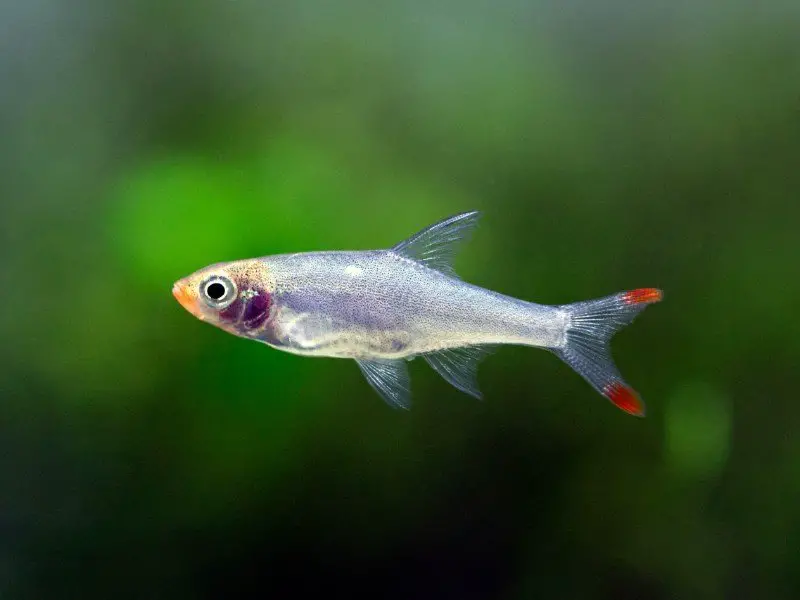
| Care level: | Temperament: | Color: | Lifespan: | Size: |
| Easy | Peaceful | Silver-blue with a bright red nose and fin tips | 4 years | 1.5 inches |
| Water temperature: | Water pH: | Tank size: | Diet: | Scientific name: |
| 64–71 °F | 6.0–8.0 | 25 gallons | Omnivore | Sawbwa resplendens |
Sawbwa barbs have a thinner, more elongated appearance than most other barbs, with a silvery-blue body patterned with bright red spots on the nose and caudal fin tips. These barbs are lively fish that swim in the middle section of the tank.
These fish can be housed in a community tank with other small fish, but male sawbwa barbs can be aggressive to males of other species. House sawbwa barbs in groups of at least eight, with two males and six females.
Sawbwa barbs are easy to feed and eat a varied omnivorous diet in captivity. Make sure to feed sawbwa barbs food that is small enough to fit in the fish’s mouths.
Tiger Barb

| Care level: | Temperament: | Color: | Lifespan: | Size: |
| Easy–Moderate | Semi-aggressive | Orange with pale mid-sections and thick black stripes | Up to 7 years | 3 inches |
| Water temperature: | Water pH: | Tank size: | Diet: | Scientific name: |
| 72–78 °F | 6.5 | 25 gallons | Omnivore | Puntius tetrazona |
The tiger barb is one of the most popular and widely-available aquarium barbs. Tiger barbs are so-called because of their distinctive black and orange, tiger-printed bodies. The tiger barb is a good fish for beginner aquarists because it is hardy and easy to feed.
These barbs are lively, sociable fish, and require plenty of open swimming space. They should be housed in groups of at least six.
Tiger barbs are fin-nippers, and male tiger barbs are more aggressive than females, so don’t house this species with long-finned, slow-swimming fish, (like guppies), and keep multiple tiger barbs together at a ratio of three females to every male.
Tinfoil Barb
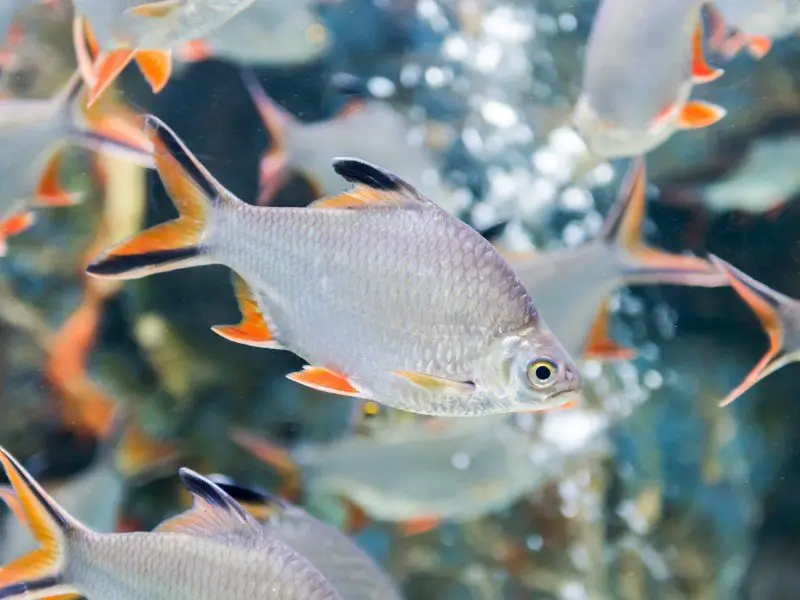
| Care level: | Temperament: | Color: | Lifespan: | Size: |
| Easy | Peaceful | Silver with orange, yellow, and black fins and tail | Up to 15 years | 14 inches |
| Water temperature: | Water pH: | Tank size: | Diet: | Scientific name: |
| 72–77 °F | 6.0–7.0 | 100 gallons | Omnivore | Barbonymus schwanenfeldii |
Tinfoil barbs require a bigger tank and more food than most barbs, but they are easy to keep. These barbs are an attractive aquarium addition, with shimmery, metallic silver scales and orange/yellow fins and an orange tail with black accents.
Because they grow so large, tinfoil barbs are suitable for large aquarium tanks of at least 100 gallons. The fish grow up to 14 inches as adults, making them unsuitable for a small home aquarium.
Although tinfoil barbs are omnivores, the fish primarily eat a herbivorous diet in the wild. Mimic this diet in captivity by feeding tinfoil barbs flake-food, chopped earthworms, and plenty of vegetables, like spinach, lettuce, and cucumber.
Ticto Barb / Odessa Barb / Red Crystal Barb

| Care level: | Temperament: | Color: | Lifespan: | Size: |
| Easy | Peaceful | Silvery gold with red markings | Undetermined, around 4–7 years | Up to 4 inches |
| Water temperature: | Water pH: | Tank size: | Diet: | Scientific name: |
| 68–74 °F | 6.5–7.5 | 25 gallons | Omnivore | Pethia ticto |
The ticto barb, also called the odessa barb or the red crystal barb, is a peaceful, hardy barb with a silver or gold body and a splash of red from the head to the tail. Ticto barbs are native to regions in Asia and India, and thrive in still, shallow, subtropical freshwater environments.
In the aquarium, ticto barbs should be housed in groups of at least six, with a ratio of at least one female to every one male. Ticto barbs don’t bother other fish when they’re housed in large-enough groups.
Ticto barbs are egg-layers, laying up to 150 eggs per successful breeding session.
Tictos are omnivores that like to feed on pellets, flakes, and live or frozen foods including insects, worms, Daphnia, and brine shrimp.
Swamp Barb

| Care level: | Temperament: | Color: | Lifespan: | Size: |
| Easy | Peaceful | Silvery-blue with a black spot | Up to 10 years | 5 inches |
| Water temperature: | Water pH: | Tank size: | Diet: | Scientific name: |
| 68–77 °F | 5.5–8.0 | 25 gallons | Omnivore | Puntius chola |
Swamp barbs have silvery-blue bodies with a black spot before the tail. Although swamp barbs don’t look as impressive as the other barbs on this list, swamp barbs are one of the easiest barb species to look after. Swamp barbs do best in groups of at least six and can be housed with other peaceful fish in a community tank.
Keep swamp barbs in a freshwater tank with still water and a sand or soil substrate to replicate the streams and lakes that the fish inhabit in the wild.
Swamp barbs are omnivores and require a varied diet of worms, plant material, small insects, and fish flakes.
Spanner Barb
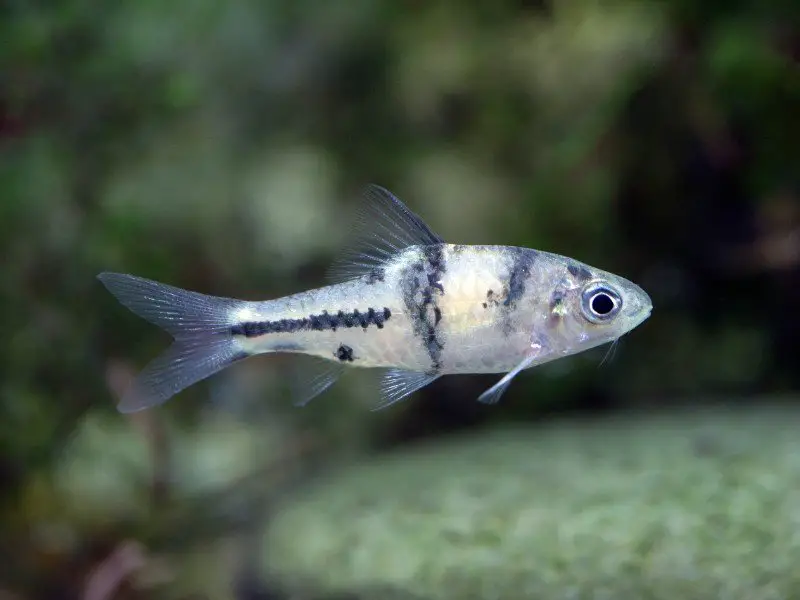
| Care level: | Temperament: | Color: | Lifespan: | Size: |
| Moderate | Semi-aggressive | Silver with dark gray markings | 8 years | 6 inches |
| Water temperature: | Water pH: | Tank size: | Diet: | Scientific name: |
| 68–82 °F | 6.0–8.0 | 30 gallons | Omnivore | Barbodes lateristriga |
The spanner barb is a silver fish with dark gray markings along its body, giving it a spanner-like appearance. Spanner barbs have pale yellow heads with small dorsal and ventral fins.
Looking after spanner barbs is easy because the fish are hardy and aren’t fussy eaters. However, because spanner barbs are a larger barb species and have boisterous personalities, you shouldn’t house them with small or easily-intimidated fish.
House spanner barbs with fish of a similar size. Prevent stress and aggression in spanner barbs by keeping a school at least six fish in your tank.
Rosy Barb
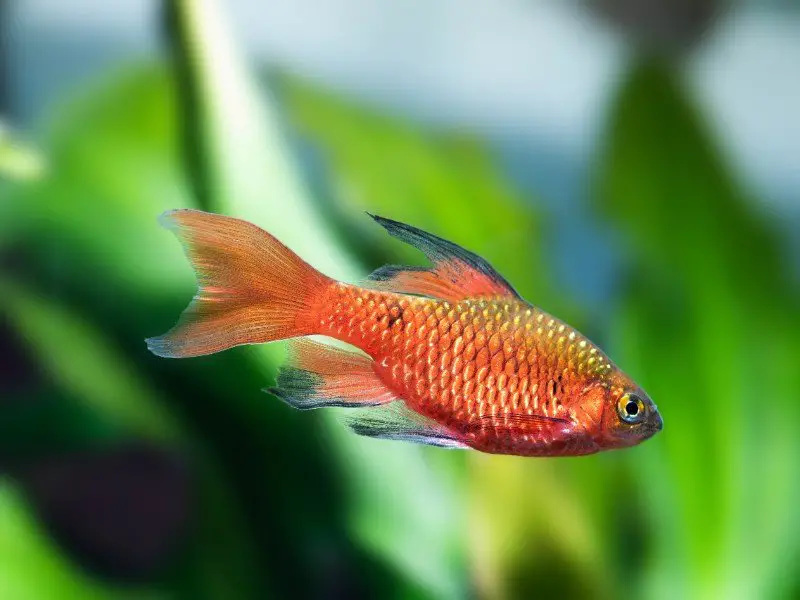
| Care level: | Temperament: | Color: | Lifespan: | Size: |
| Easy | Peaceful | Orange-gold with a pinkish hue | 5 years | 6 inches |
| Water temperature: | Water pH: | Tank size: | Diet: | Scientific name: |
| 64–72 °F | 6.0–8.0 | 30 gallons | Omnivore | Pethia conchonius |
Rosy barbs are one of the most popular barb species for home aquariums because their bright coloring and peaceful personalities make them fun to watch.
In fact, rosy barbs are one of the largest barb species. They have torpedo-shaped, pinkish-colored bodies and forked tails.
This barb species enjoys the company of other rosy barbs, and housing these fish in a school of at least six will prevent them from bothering other fish species.
As opportunistic eaters, rosy barbs eat a variety of foods including plant matter, fish flakes, and meaty foods like worms and brine shrimp.
Redside Barb / Two-Spot Barb
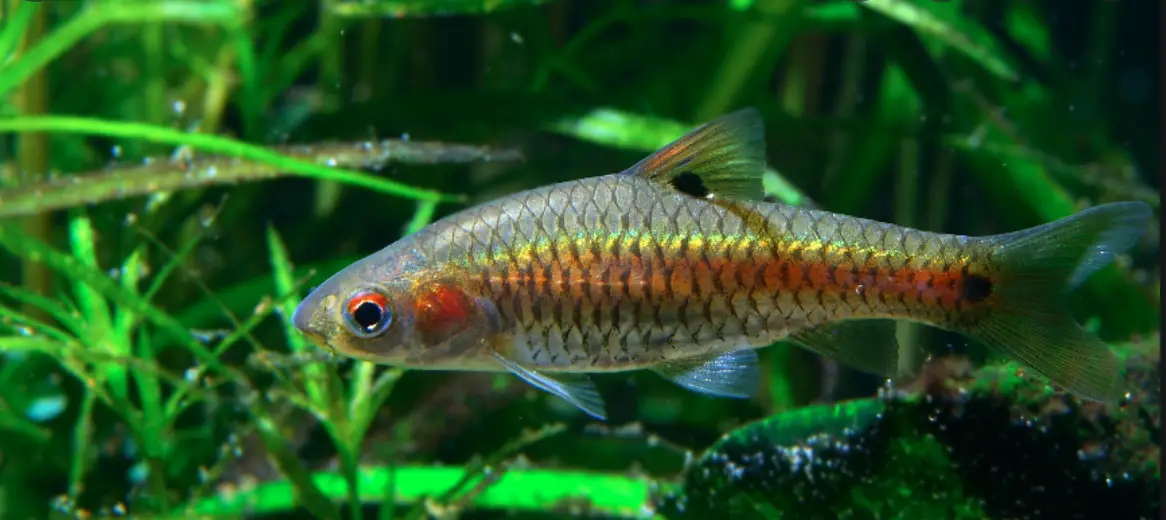
| Care level: | Temperament: | Color: | Lifespan: | Size: |
| Easy | Peaceful | Silver with two black spots | 6 years | 2 inches |
| Water temperature: | Water pH: | Tank size: | Diet: | Scientific name: |
| 65–75 °F | 6.0–7.5 | 25 gallons | Omnivore | Puntius bimaculatus |
The redside barb, or two-spot barb, is a beautiful species of barb originating from southern India. Redside barbs have silver bodies with two black spots: one near the head and one near the tail. The fish are a small barb species, growing up to 2 inches.
Because they don’t require specific water parameters, redside barbs can be flexible to the parameters of other fish.
Redside barbs are peaceful and sociable. House redside barbs with popular fish like tetras, catfish, and loaches. Redside barbs are schooling fish by nature, and should be housed in groups of at least six.
Checker Barb
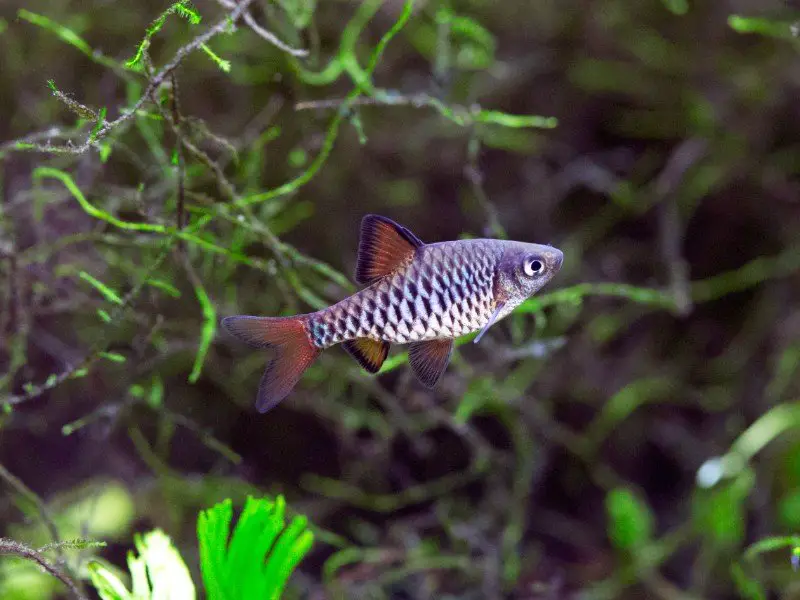
| Care level: | Temperament: | Color: | Lifespan: | Size: |
| Easy | Peaceful | Black and silver | 8 years | 2 inches |
| Water temperature: | Water pH: | Tank size: | Diet: | Scientific name: |
| 68–78 °F | 6.0–7.5 | 30 gallons | Omnivore | Oliotius oligolepis |
Checker barbs, or checkered barbs, have black and silver markings that resemble a checkerboard. They are schooling fish that need to be kept in groups of at least nine.
Because checker barbs are fin-nippers, you shouldn’t house these barbs with long-finned, slow-swimming fish. When housed in the right tank conditions, checker barbs are low-maintenance, lively fish.
Checker barbs are prone to bloating, so don’t feed them worms and avoid overfeeding.
Cherry Barb

| Care level: | Temperament: | Color: | Lifespan: | Size: |
| Easy | Peaceful | Bright red with a horizontal black line | 4 years | 2 inches |
| Water temperature: | Water pH: | Tank size: | Diet: | Scientific name: |
| 73–81 °F | 6.0–7.5 | 25 gallons | Omnivore | Puntius titteya |
Cherry barbs are a standout barb species, with bright, cherry-red coloring and a horizontal black line that spans from the head to the tail. These barbs should be housed in a planted tank, in schools of at least six.
A school of cherry barb fish makes for suitable tank mates for similarly-tempered fish, as well as for non-fish species like shrimp and crabs. Choose a dark substrate for the tank to allow the cherry barb’s colors to pop.
Cherry barbs are opportunistic omnivores and will eat almost anything, including algae, brine shrimp, and fish flakes.
Arulius Barb
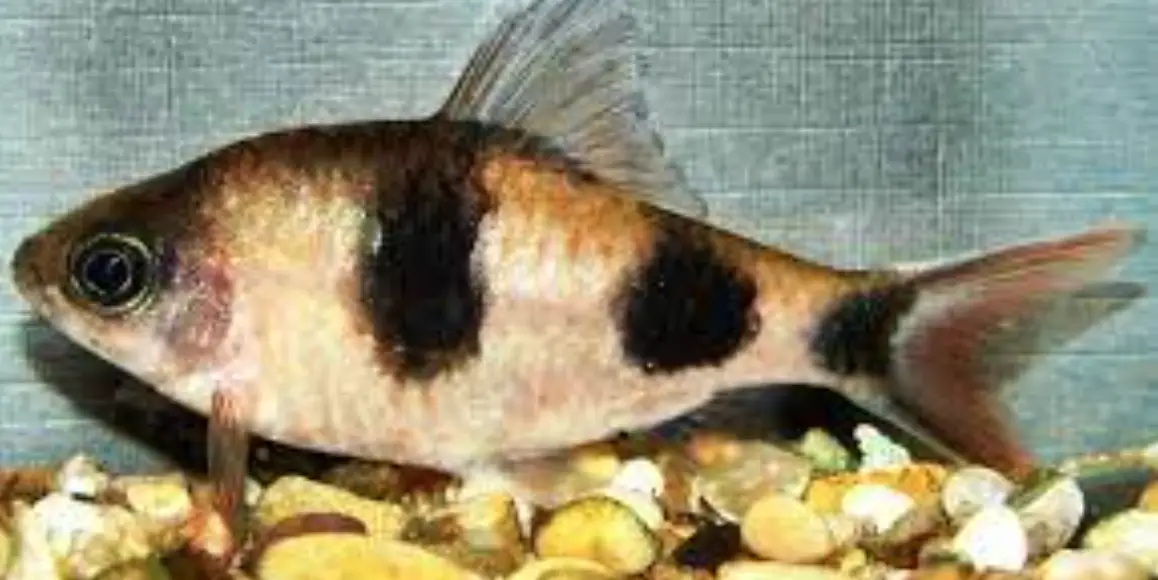
| Care level: | Temperament: | Color: | Lifespan: | Size: |
| Easy | Peaceful | Brownish-olive | 6 years | 4 inches |
| Water temperature: | Water pH: | Tank size: | Diet: | Scientific name: |
| 66–77 °F | 6.0–7.5 | 30 gallons | Omnivore | Dawkinsia arulius |
Arulius barbs are light brown on the sides and white on the ventral surface. The fish have several black blotches: one in the middle of the body and one above the anal fin.
While these barbs aren’t as common amongst aquarium hobbyists as other barbs, arulius barbs are peaceful and hardy, making them ideal for community tanks.
House arulius barbs in spacious, well-oxygenated tanks with lots of vegetation. Arulius barbs enjoy a varied diet, but be careful not to overfeed these fish, as they will overeat if you let them.
Keep arulius barbs in groups of at least eight to ensure the fish are comfortable, and to reduce their fin-nipping tendencies.
Choosing & Caring For Different Types of Barb Fish
Barbs are peaceful, hardy fish that are a staple in most home aquariums. To care for barbs, feed the fish a varied omnivorous diet, and maintain clean, consistent water conditions.
To choose the right barb for you, consider the following things:
- How big is your tank? Some barbs grow up to 6 inches long and require tanks of at least 30 gallons.
- What colored barbs will best complement the fish already housed in your tank? Barbs come in a variety of colors.
- Does your tank have long-finned fish? Some barbs are fin-nippers.
You can house most barb species together. Rosy barbs, cherry barbs, and tiger barbs are the best barbs to house in a mixed community tank. In general, barbs are difficult to breed, so breeding is best left to advanced aquarists.

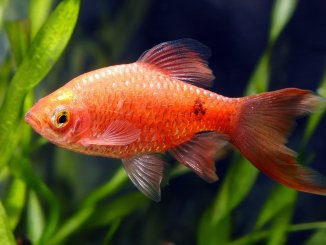
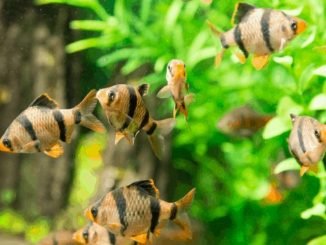
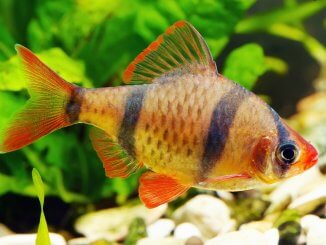
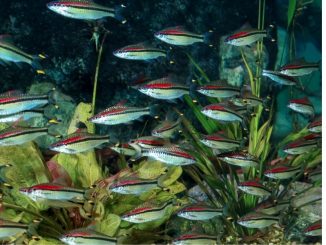
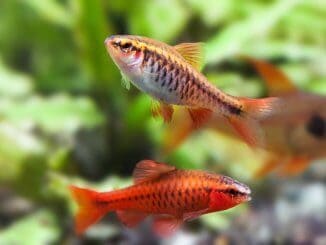
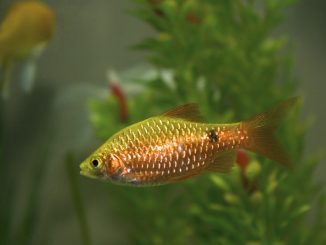
Be the first to comment